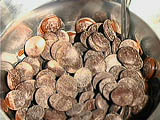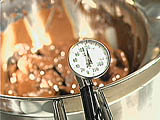![]()
![]()
|
|
|
|
Step 1.
Step 2.
Step 5.
Using the rubber spatula, mix the chocolate until all of it is completely melted. If the chocolate is not fluid enough, place the bowl over the hot water for a few seconds and stir. Then remove from the heat and wipe the moisture off the bottom of the bowl. You're now ready to use the melted chocolate to create candies (see the sidebar for some simple procedures). Check the temperature one more time. If you used dark chocolate, the temperature should be between 85 and 90 degrees. If you used white or milk chocolate it should be around 85 or 86 degrees. |
Chocolate-Dipped
Cool Chocolate
Bowls
Before you begin the tempering process, you'll need to blow up a number of small balloons to about the size of coffee cup. Take your blown-up balloons and dip them halfway into the melted chocolate. Make sure the "tied" side is up. Swirl the balloon gently around to produce an even coat. Then lift the balloon slowly to let some of the excess chocolate drip back into the bowl. Place the balloon on a lined cookie sheet. The chocolate should start to settle and the balloon will stand up on the pan. Repeat the process for as many cups as you'd like to make. Then place the pan into the refrigerator for 5 to 8 minutes. When you remove the pan from the refrigerator, the chocolate surrounding the balloons should be hard.
Use the hat pin to carefully poke a small hole at the top of the balloon, near the knot. [Click here to see a Quicktime movie of this procedure (625k) ] As the balloon deflates, gently pull it away from the chocolate cups. When you're done, you can fill the cups with fruit (berries work well) and whipped cream, cold pudding, ice cream, or chocolate mousse. Be creative, and enjoy! |
|
|
 Step
3.
Step
3.
 Step
4.
Step
4.
